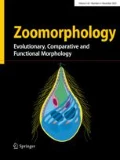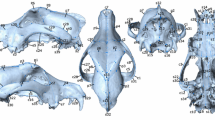Abstract
The dingo is a wild canid introduced to Australia within the last 5000 years. Existing research has identified up to three evolutionarily significant, geographically separated distinct populations of dingo on the Australian mainland. Contending explanations variably invoke ancient population substructure, separate introductions in antiquity, and disparate levels of recent domestic dog admixture. Here, I present an assessment of morphological variation in the dingo, applying 3D geometric morphometrics to compare the cranial forms of individuals from different regions in Australia, with the dingo’s closest relatives, New Guinea Singing Dogs, domestic dogs and dingo-dog hybrids. Dingoes from southeastern Australia were found to be morphologically distinct from conspecifics to their northwest, including both desert, tropical and Fraser Island dingoes, being intermediate to New Guinea Singing Dogs. The close resemblance of these results to genetic population subdivisions indicates that dingo morphology likely reflects ancient population substructure related to a complex prehistoric introduction and dispersal scenario, rather than solely introgression from domestic dogs.







Similar content being viewed by others
References
Baab KL, McNulty KP, Harvati K (2013) Homo floresiensis contextualized: a geometric morphometric comparative analysis of fossil and pathological human samples. PLoS ONE 8:e69119. https://doi.org/10.1371/journal.pone.0069119
Ballard G, Wilson LAB (2019) The Australian dingo: untamed or feral? Front Zool 16:1–19
Balme J, O’Connor S, Fallon S (2018) New dates on dingo bones from Madura Cave provide oldest firm evidence for arrival of the species in Australia. Sci Rep 8:9933. https://doi.org/10.1038/s41598-018-28324-x
Breckwoldt R (1988) A very elegant animal: the dingo. Angus and Robertson, Sydney
Brook LA, Johnson CN, Ritchie EG (2012) Effects of predator control on behaviour of an apex predator and indirect consequences for mesopredator suppression. J Appl Ecol 49:1278–1286. https://doi.org/10.1111/j.1365-2664.2012.02207.x
Brown SK et al (2011) Phylogenetic distinctiveness of middle eastern and southeast Asian village dog Y Chromosomes illuminates dog origins. PLoS ONE 6:e28496. https://doi.org/10.1371/journal.pone.0028496
Cairns KM, Wilton AN (2016) New insights on the history of canids in Oceania based on mitochondrial and nuclear data. Genetica 144:553–565
Cairns KM, Brown SK, Sacks BN, Ballard JWO (2017) Conservation implications for dingoes from the maternal and paternal genome: multiple multiple populations, dog introgression, and demography. Ecol Evol 7:9787–9807. https://doi.org/10.1002/ece3.3487
Cairns KM, Shannon LM, Koler-Matznick J, Ballard JWO, Boyko AR (2018) Elucidating biogeographical patterns in Australian native canids using genome wide SNPs. PLoS ONE 13:e0198754. https://doi.org/10.1371/journal.pone.0198754
Caughley G, Grigg GC, Caughley J, Hill GJE (1980) Does dingo predation control the densities of kangaroos and emus. Aust Wildl Res 7:1–12
Cignoni P, Callieri M, Corsini M, Dellepiane M, Ganovelli F, Ranzuglia G (2008) MeshLab: an open-source mesh processing tool. In: Scarano V (ed) Sixth eurographics Italian chapter conference, Salerno, Italy, Eurographics Association, pp 129–136
Colman NJ (2015) Morphological variation and ecological interactions of Australia's apex predator—the dingo (Canis dingo). University of Western Sydney, Sydney
Contos P, Letnic M (2019) Top-down effects of a large mammalian carnivore in arid Australia extend to epigeic arthropod assemblages. J Arid Environ 165:16–27
Corbett LK (1985) Morphological comparisons of Australian and Thai dingoes: a reappraisal of dingo status, distribution and ancestry. Proc Ecol Soc Aust 13:277–291
Corbett LK (1995) The dingo in Australia and Asia. Cornell University Press, New York
Corbett LK (2001) The conservation status of the dingo Canis lupus dingo in Australia, with particular reference to New South Wales: threats to pure dingoes and potential solutions. In: Dickman CR, Lunney D (eds) A symposium on the dingo. Royal Society of New South Wales, Sydney, pp 10–19
Corbett LK (2006) The Australian dingo. In: Merrick JR, Archer M, Hickey GM, Lee MSY (eds) Evolution and biogeography in Australia. Auscipub Pty Ltd, Sydney, pp 745–751
Corporation S (2018) Stratovan checkpoint 2018.08.07 edn
Daniels MJ, Corbett LK (2003) Redefining introgressed protected mammals: When is a wildcat a wild cat and a dingo a wild dog? Wildl Res 30:213–218
Derr M (2012) How the dog became the dog: from wolves to our best friends. Duckworth Overlook, London
Drake AG (2011) Dispelling dog dogma: an investigation of heterochrony in dogs using 3D geometric morphometric analysis of skull shape. Evol Dev 13:204–213
Dwyer PD, Minnegal M (2016) Wild dogs and village dogs in New Guinea: Were they different? Aust Mammal 38:1–11
Elledge AE, Leung LKP, Allen LR, Firestone K, Wilton AN (2006) Assessing the taxonomic status of dingoes Canis familiaris dingo for conservation. Mammal Rev 36:142–156. https://doi.org/10.1111/j.1365-2907.2006.00086.x
Fillios M, Gordon C, Koch F, Letnic M (2010) The effect of a top predator on kangaroo abundance in arid Australia and its implications for archaeological faunal assemblages. J Archaeol Sci 37:986–993. https://doi.org/10.1016/j.jas.2009.11.031
Geiger M, Evin A, Sánchez-Villagra MR, Gascho D, Mainini C, Zollikofer CPE (2017) Neomorphosis and heterochrony of skull shape in dog domestication. Sci Rep 7(1):13443
Germonpré M, Galetova M, Sablin M, Bocherens H (2018) Self-domestication or human control? The Upper Palaeolithic domestication of the wolf. In: Stépanoff C, Vigne J-D (eds) Hybrid communities: biosocial approaches to domestication and other trans-species relationships. Routledge, London, pp 39–64
Gollan K (1982) Prehistoric dingo. Australian National University, Canberra
Greig K et al (2018) Complex history of dog (Canis familiaris) origins and translocations in the Pacific revealed by ancient mitogenomes. Sci Rep 8:9130. https://doi.org/10.1038/s41598-018-27363-8
Grey G (1841) Journal of two expeditions of discovery in north-west and western Australia, 1st edn. T&W Boone, London
Hayden B (1975) Dingoes: pets or producers? Mankind 10:11–15
Jackson SM, Groves CP, Fleming PJS, Aplin KP, Eldridge DB, Gonzalez A, Helgen K (2017) The wayward dog: is the Australian native dog or dingo a distinct species? Zootaxa 4317:201–224
Johnson CN, Isaac JL, Fisher DO (2007) Rarity of a top predator triggers continent wide collapse in mammal prey: dingoes and marsupials in Australia. Proc R Soc B 274:341–346
Jolliffe IT (2002) Principial component analysis, 2nd edn. Springer-Verlag, New York
Jones E (1990) Physical characteristics and taxonomic status of wild canids, canis-familiaris, from the eastern highlands of victoria. Wildl Res 17:69–81
Jones E (2009) Hybridisation between the dingo, Canis lupus dingo, and the domestic dog, Canis lupus familiaris, in Victoria: a critical review. Aust Mammal 31:1–7
Klingenberg CP (2011) MorphoJ: an integrated software package for geometric morphometrics. Mol Ecol Resour 11:353–357
Klingenberg CP (2016) Size, shape, and form: concepts of allometry in geometric morphometrics. Dev Genes Evol https://doi.org/10.1007/s00427-016-0539-2
Koler-Matznick J (2016) Dawn of the dog: the genesis of a natural species. Cynology Press, Central Point
Koler-Matznick J, Yates BC, Bulmer S, Brisbin IL Jr (2007) The New Guinea singing dog: its status and scientific importance. Aust Mammal 29:47–56
Letnic M, Fillios M, Crowther MS (2012) Could direct killing by larger dingoes have caused the extinction of the Thylacine from Mainland Australia? PLoS ONE 7:e34877. https://doi.org/10.1371/journal.pone.0034877
Lyons MB, Mills CH, Gordon CE, Letnic M (2018) Linking trophic cascades to changes in desert dune geomorphology using high-resolution drone data. J R Soc Interface 15(144):20180327
Machado FA, Zahn TMG, Marroig G (2018) Evolution of morphological integration in the skull of Carnivora (Mammalia): Changes in Canidae lead to increased evolutionary potential of facial traits. Int J Org Evol 72:1399–1419
Meachen JA, Janowicz AC, Avery JE, Sadleir RW (2014) Ecological changes in coyotes (Canis latrans) in response to the Ice Age megafaunal extinctions. PLoS ONE 9:e116041
Newsome AE, Corbett LK (1982) The identity of the dingo II.* Hybridization with domestic dogs in captivity and in the wild Australian. J Zool 30:365–374
Newsome AE, Corbett LK (1985) The identity of the dingo III.* The incidence of dingoes, dogs and hybrids and their coat colours in remote and settled regions of Australia. Aust J Zool 33:363–375
Newsome AE, Corbett LK, Carpenter SM (1980) The identity of the dingo I. Morphological discriminants of dingo and dog skulls. Aust J Zool 28:615–625
Parr WCH, Wilson LAB, Wroe S, Colman NJ, Crowther MS, Letnic M (2016) Cranial shape and the modularity of hybridization in dingoes and dogs; hybridization does not spell the end for native. Morphol Evolut Biol 43:171–187. https://doi.org/10.1007/s11692-016-9371-x
Petrie CG (1904) Reminscences of early Queensland. Watson, Ferguson and Co., Brisbane
Pilot M et al (2015) On the origin of mongrels: evolutionary history of free-breeding dogs in Eurasia. Proc R Soc B 282(1820):2015–2189
Piper PJ (2017) The origins and arrival of the earliest domestic animals in Mainland and Island Southeast Asia: a developing story of complexity. In: New erspectives in Southeast Asian and Pacific prehistory, vol 45. ANU Press, Canberra, pp 251–274
Radford CG, Letnic M, Fillios M, Crowther MS (2012) An assessment of the taxonomic status of wild canids in south-eastern New South Wales: phenotypic variation in dingoes. Aust J Zool 60:73–80
Savolainen P, Leitner T, Wilton AN, Matisoo-Smith E, Lundeberg J (2004) A detailed picture of the origin of the Australian dingo, obtained from the study of mitochondrial DNA. Proc Natl Acad Sci USA 101:12387–12390. https://doi.org/10.1073/pnas.0401814101
Schmitt E, Wallace S (2014) Shape change and variation in the cranial morphology of wild canids (Canis lupus, Canis latrans, Canis rufus) compared to domestic dogs (Canis familiaris) using geometric morphometrics. Int J Osteoarchaeol 24:42–50
Smith BP (2015) The dingo debate: origins, behaviour and conservation. CSIRO Publishing, Canberra
Smith BP, Litchfield CA (2009) A review of the relationship between indigenous Australians, dingoes (Canis dingo) and domestic dogs (Canis familiaris). Anthrozoös 22:111–128
Smith B et al (2019) Taxonomic status of the Australian dingo: the case for Canis dingo Meyer, 1793. Zootaxa 4564:173–197. https://doi.org/10.11646/zootaxa.4564.1.6
Stephens D, Wilton AN, Fleming PJS, Berry O (2015) Death by sex in an Australian icon: a continent-wide survey reveals extensive hybridization between dingoes and domestic dogs. Mol Ecol 24:5643–5656. https://doi.org/10.1111/mec.13416
Troughton ELG (1957) A new native dog from the Papuan Highlands. In: Proceedings of the royal zoological society New South Wales, vol 1955–1956, pp 93–94
Wallach AD, Ritchie EG, Read JL, O'Neill AJ (2009) More than mere numbers: the impact of lethal control on the social stability of a top-order predator. PLoS ONE 4(9):e6861
Wallach AD, Johnson CN, Ritchie EG, O’Neill AJ (2010) Predator control promotes invasive dominated ecological states. Ecol Lett 13:1008–1018. https://doi.org/10.1111/j.1461-0248.2010.01492.x
White LC, Saltré F, Bradshaw CJA, Austin JJ (2018) High-quality fossil dates support a synchronous, Late Holocene extinction of devils and thylacines in mainland. Aust Biol Lett 14(1):20170642
Woodall PF, Pavlov P, Twyford KL (1996) Dingoes in Queensland, Australia: skull dimensions and the identity of wild canids. Wildl Res 23:581–587
Yravedra J, Aramendi J, Maté-González MÁ, Austin Courtenay L, González-Aguilera D (2018) Differentiating percussion pits and carnivore tooth pits using 3D reconstructions and geometric morphometrics. PLoS ONE 13:e0194324. https://doi.org/10.1371/journal.pone.0194324
Zhang S-J et al (2018) Genomic analysis of dingoes identifies genomic regions under reversible selection during domestication and feralization. BioRxiv. https://doi.org/10.1101/472084
Acknowledgements
Many thanks go to the Museums and their staff who assisted in my study of their collections: Sandy Ingleby, Harry Parnaby, Matthew McCurry and Allison Dejanovic at the Australian Museum; Denise Donlon at the Shellshear Museum; Jude Philp at the Macleay Museum; Karen Roberts and Tim Ziegler at Melbourne Museum, Leo Joseph and Chris Wilson at the CSIRO National Wildlife Collection; Heather Janetzki at the Queensland Museum; Gavin Dally and Rebecca Mirams at MAGNT, and Molly Hagemann at the Bishop Museum. I benefited from advice offered by Peter Hiscock and Amy Tabrett concerning Principal Components Analysis and allometry, from Kylie Cairns and Peter Savolainen regarding dingo population genetics, and general feedback from Val Attenbrow on this manuscript, as well as that of the anonymous reviewers. Thanks also go the providers of photographs of dingoes through Shutterstock.
Funding
This research was funded by an Australian Government Research Training Program (RTP) scholarship, and further supported by the University of Sydney’s Carlyle-Greenwell Research Fund.
Author information
Authors and Affiliations
Corresponding author
Ethics declarations
Conflict of interest
Not applicable.
Ethical approval
Not applicable.
Informed consent
Not applicable.
Additional information
Publisher's Note
Springer Nature remains neutral with regard to jurisdictional claims in published maps and institutional affiliations.
Electronic supplementary material
Below is the link to the electronic supplementary material.
Rights and permissions
About this article
Cite this article
Koungoulos, L. Old dogs, new tricks: 3D geometric analysis of cranial morphology supports ancient population substructure in the Australian dingo. Zoomorphology 139, 263–275 (2020). https://doi.org/10.1007/s00435-019-00475-z
Received:
Revised:
Accepted:
Published:
Issue Date:
DOI: https://doi.org/10.1007/s00435-019-00475-z




